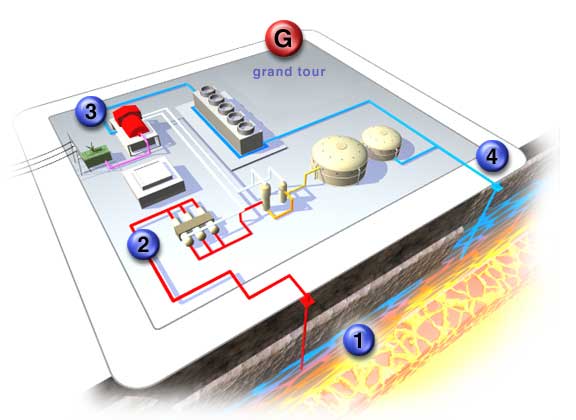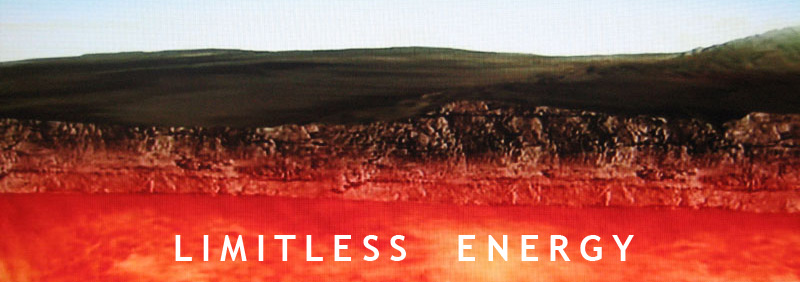Presently, wells are drilled into the geothermal reservoirs to bring the hot water to the surface. At Conventional Geothermal Power Plants, this hot water is piped to the surface. Then, after removing silica and solids in a "separators", steam is created and used to spin turbines creating mechanical energy. The shaft from the turbines to the generator converts mechanical energy to electrical energy. The used geothermal water is then returned down through an injection well into the reservoir to be reheated, to maintain pressure, and to sustain the reservoir.
There are three kinds of Conventional Geothermal Power Plants. The kind we build depends on the temperatures and pressures of a reservoir.
A "dry'" steam reservoir produces steam but very little water. The steam is piped directly into a "dry" steam power plant to provide the force to spin the turbine generator. The largest dry steam field in the world is The Geysers, about 90 miles north of San Francisco. Production of electricity started at The Geysers in 1960, at what has become the most successful alternative energy project in history.
A geothermal reservoir that produces mostly hot water is called a "hot water reservoir" and is used in a "flash" power plant. Water ranging in temperature from 300 - 700 degrees F is brought up to the surface through the production well where, upon being released from the pressure of the deep reservoir, some of the water flashes into steam. The steam then powers the turbines.
A reservoir with temperatures between 250 - 360 degrees F is not hot enough to flash enough steam but can still be used to produce electricity in a "binary" power plant. In a binary system the geothermal water is passed through a heat exchanger, where its heat is transferred into a second (binary) liquid, such as isopentane, that boils at a lower temperature than water. When heated, the binary liquid flashes to vapor, which, like steam, expands across and spins the turbine blades. The vapor is then condensed to a liquid and is reused repeatedly. In this closed loop cycle, there are no emissions to the air.
It's also a proven, relatively clean energy source. More than 30 nations sitting in earthquake and volcanic zones have extensively used geothermal power for decades.

Here is illustrated an existing geothermal power plant operation (courtesy of CalEnergy).
Limitations and disadvantages of the Conventional Geothermal Power Plants
At the present time use of geothermal energy is very limited.
To mention just a few limitations:
1.Presently, Conventional Geothermal Power Plants are limited to the "shallow" naturally formed hydrothermal reservoirs. Naturally formed hydrothermal reservoirs are rear in comparison with dry hot rocks which are everywhere.
2.Hydrothermal reservoirs are sometimes located in restricted area such as the geysers at Yellowstone National Park.
3.There are many necessary steps and apparatuses in existing production process such as separators for filtering water, removing and handling silica and solids, equipment corrosion, scaling, etc.
4.Although used geothermal water is returned down through an injection well into the reservoir to be reheated, to maintain pressure, and to sustain the reservoir, the lost of water in process and gradually depletion of the reservoir is noticeable.
 Geothermal Worldwide, Inc.
Geothermal Worldwide, Inc.
